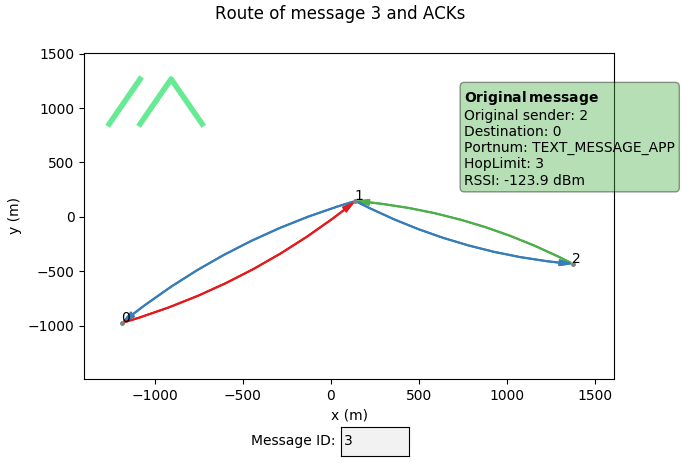Why Meshtastic Uses Managed Flood Routing
Designing a low-bandwidth wireless mesh network to run on low-power microprocessors with limited memory is challenging. Arguably the simplest mesh routing protocol is Flood Routing: each radio receiving a packet will rebroadcast this again, up to a defined hop limit. Although Meshtastic is based on this strategy, there are a few subtle, but significant enhancements. Most importantly, before a node rebroadcasts, it waits a short while and listens if anyone else is already rebroadcasting. If so, it will not rebroadcast again. Therefore, “Managed Flood Routing” would be a better name. For more details on the enhancements, please review our documentation.
Since Flood Routing is not very efficient, we realize that this approach is not perfect. The firmware has a number of measures in place to limit traffic in order not to overwhelm a mesh, but as with any RF based protocol, there are limitations to the capacity of the mesh. In attempts to enhance the efficiency, we have evaluated “smarter” routing protocols at times in the past. However, we have yet to find anything that would consistently outperform the current approach in the use-cases and scenarios Meshtastic is currently being utilized. We’ll go over several reasons for why we believe Managed Flood Routing remains a superior approach for Meshtastic.
Key Advantages of Meshtastic's Managed Flood Routing
- Eliminates route discovery overhead
- Provides superior adaptation to dynamic network topologies
- Optimized for broadcast-heavy traffic patterns common in Meshtastic
- Demonstrates excellent scalability in low-bandwidth environments
- Minimizes resource utilization on constrained IoT devices
- Empirically validated through extensive network simulations
Avoids Route Discovery
First and foremost, Managed Flood Routing eliminates the need for route discovery or centralized control. In traditional routing algorithms, devices rely on predefined or dynamic routes to forward messages to their destinations. With Managed Flood Routing, you can start messaging immediately after booting your device. Furthermore, route discovery and maintenance leads to overhead, which quickly becomes very significant with a low-bandwidth protocol such as LoRa. In order to maintain routes, either additional control packets are needed, or metadata has to be added to normal traffic. Either increases utilization of precious airtime. In static scenarios, this is not a significant issue, but when the topology changes often -as we discuss in the next section- the overhead quickly outweighs the benefit of a smarter routing protocol.
Seamlessly Adapts to Network Topology Changes
Another significant advantage of Managed Flood Routing is its ability to adapt to network topology changes. In mesh networks, devices can join or leave the network at any time, and in the case of Meshtastic, nodes are often mobile causing the network topology to change frequently. Even environmental changes such as the weather or the time of day may influence routes. Traditional routing algorithms struggle to keep up with these changes, often leading to message loss or delays. Managed Flood Routing, however, excels in such scenarios. As each device will participate in the routing when called upon, the network quickly adapts to the changes, ensuring that messages find their way to the destination even in the face of frequent topology changes.
Inefficiency is Limited
A routing protocol aims to deliver packets at the destination in the most efficient way possible. Indeed for packets with a single destination, a lot can be gained by choosing only one efficient route. However, for broadcasts the potential gain is limited, as it is intended to be delivered to every node in the mesh. Since the majority of packets in Meshtastic are broadcasts rather than messages targeting a specific node, a smarter protocol would have limited influence. Additionally, in a wireless medium, even if a packet is directed to a certain node, all nodes in range will witness it and during that time they cannot transmit or receive another packet, meaning that even with a perfect routing protocol, nodes that may not be interested in a packet will still receive it, especially if they have good receiver sensitivity, which is frequently the case for LoRa.
Provides Scalability on low-bandwidth LoRa transport
Furthermore, Managed Flood Routing is certainly scalable, because nodes that are unlikely to contribute to routing will not participate. In large-scale mesh networks, where hundreds of devices are meshing, scalability becomes a critical factor, and minimizing airtime is king. Traditional routing algorithms often struggle to handle the increasing number of devices and the associated routing overhead, due to the additional control messages required to maintain routes with highly ephemeral topologies. On the other hand, with Managed Flood Routing, new devices joining the network integrate into the routing process without any additional ceremony, contributing to the overall network resilience and message delivery efficiency.
Functions on Resource Constrained Devices
Finally, Managed Flood Routing minimizes footprint on very resource-constrained low power IoT devices. Traditional routing algorithms often require devices to maintain large routing tables or perform complex calculations, consuming additional RAM, flash, and valuable computational resources. Managed Flood Routing, with its simplicity and distributed nature, significantly reduces the resource overhead. Devices only need to forward messages they receive, without the need for complex computations, resulting in more device resource availability for other valuable features and improved device autonomy.
Many decisions are based on data from Meshtasticator simulations
Considerations and Future Directions
While Managed Flood Routing has proven highly effective for Meshtastic, we acknowledge its limitations:
- Not optimal for all network configurations
- Potential for improvement in specific unicast scenarios
- Ongoing research into hybrid approaches for future implementations
The current Managed Flood Routing is not perfect and success is not guaranteed, but it has been proven to be effective even in large meshes of more than 100 nodes with proper traffic control. There are trade-offs associated with any approach, and utilizing any “smarter” protocol will inevitably lead to overhead in several ways which, in our view, can quickly diminish its benefits.


